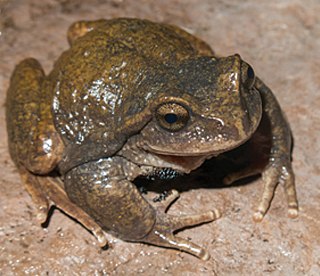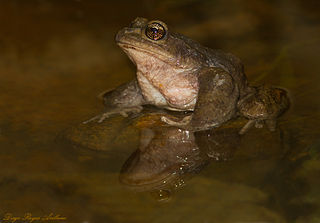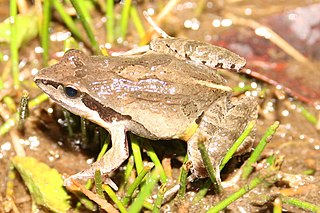Astylosternus schioetzi is a species of frog in the family Arthroleptidae. It is endemic to south-western Cameroon and is only known from two areas near Edéa, Apouh and Koupongo, separated by the Sanaga River. The specific name schioetzi honours Arne Schiøtz, a Danish herpetologist who has worked extensively on African tree frogs. Common name Apouh night frog has been coined for this species.

Alsodes australis is a species of frog in the family Alsodidae found in western Argentina and eastern Chile from 46°25′S to 42°25′N. Its natural habitat is cold mountain streams of austral temperate Nothofagus forest. A potential threat to this species are introduced predatory salmonid fishes, but so far little is known about its population status.

Alsodes gargola, with the common name Tonchek spiny-chest frog, is a species of frog in the family Alsodidae. It is endemic to Argentina, where it occurs in northern Patagonia.

Alsodes hugoi is a species of frogs in the family Alsodidae. It is endemic to Chile and only known from its type locality, Río Lircay, in Alto de Vilches, Talca Province, on the western slopes of the Andes. The specific name hugoi honors Professor Hugo Campos Cereceda, for his "remarkable contributions to the development of the natural sciences in Chile".
Alsodes igneus is a species of frogs in the family Alsodidae endemic to Chile; it is only known from its type locality, Tolhuaca National Park, Malleco Province, on the western slopes of the Andes. The specific name igneus, meaning "something that is of fire", was chosen to symbolize the survival of the population from a great forest fire that affected the type locality in 2000.
Alsodes kaweshkari is a species of frog in the family Alsodidae. This rare species is endemic to southern Chile where it is known from two specimens, the holotype that was collected from Puerto Edén, and one paratype from Seno Huemules on the mainland.

Alsodes monticola is a species of frog in the family Alsodidae. It is found in southern Chile and western Santa Cruz Province, Argentina, though its presence in Argentina is disputed. Its habitat preferences are not known, but the region of the type locality has tundra and islands of Nothofagus forest.

Alsodes nodosus is a species of frog in the family Alsodidae endemic to central Chile; records from Argentina are not considered valid.

Alsodes pehuenche is a species of frog in the family Alsodidae. It is endemic to Pehuenche Valley in the Andes of southern Mendoza Province, Argentina, and the adjacent Chile. At the time of the assessment by the International Union for Conservation of Nature (IUCN) in 2012, the species was known from six streams in an area encompassing some 9 km². A study published in 2013 extended the known range a few kilometers west and included another Chilean stream.

Alsodes valdiviensis is a species of frogs in the family Alsodidae. It is endemic to Chile and only known from its type locality, Cerro Mirador in the Cordillera Pelada, Valdivia Province. The specific name refers to this province.

Alsodes vanzolinii is a species of frog in the family Alsodidae.

Alsodes verrucosus is a species of frog in the family Alsodidae. It is found in the Andes of Chile and Neuquén and Río Negro Provinces, Argentina. These frogs inhabit temperate Nothofagus forest where they occur under logs and near damp areas. Tadpoles develop in cold, deep streams. It is threatened by habitat loss caused by logging.
Alsodes vittatus is a species of frog in the family Alsodidae. It is endemic to Chile and only known from its type locality, San Ignacio de Pemehue, Malleco Province. It may be threatened by habitat loss through pine plantations and it is not known from any protected areas. It has not been seen since its discovery and searches in 1995, 1996 and 2002 failed to find it.
Paratelmatobius gaigeae is a species of frog in the family Leptodactylidae. It is endemic to Serra da Bocaina, a part of Serra do Mar, southeastern Brazil. Paratelmatobius gaigeae is named after Helen Beulah Thompson Gaige, an American herpetologist.

Physalaemus barrioi is a species of frog in the family Leptodactylidae. It is endemic to Serra do Bocaina in São Paulo state, Brazil. The specific name barrioi honors Avelino Barrio, a Spanish botanist and zoologist who lived in Argentina. However, the common name Bocaina dwarf frog has been proposed for it.
Telmatobius pefauri is a species of frog in the family Telmatobiidae. It is endemic to extreme northern Chile. It was already feared that this species is extinct, but recent research has suggested that the species is extant at several localities in the Arica y Parinacota Region, albeit at low numbers. Furthermore, morphological and genetic data suggest that Telmatobius zapahuirensis is a synonym of Telmatobius pefauri. Common name Arico water frog has been coined for this species.
Amolops bellulus is a species of frog in the family Ranidae that is endemic to the Gaoligong Mountains. It is only known from the area of its type locality in Nujiang Lisu Autonomous Prefecture in Yunnan, China, but it is expected to occur in the adjacent Myanmarian part of the mountains. Amolops bellulus lives in and near fast-flowing mountain streams. Its status is insufficiently known.
Ptychadena ingeri is a species of frog in the family Ptychadenidae. It is endemic to the north-eastern Democratic Republic of the Congo where it is known from the Garamba National Park. It is likely to occur more widely, possibly reaching into South Sudan. It is named after Robert F. Inger, an American zoologist from the Field Museum of Natural History. Common name Inger's grassland frog has been coined for it.
Odorrana kuangwuensis is a species of frog in the family Ranidae that is endemic to China. It is found in northeastern Sichuan and northwestern Hubei. Its name refers to the type locality, Mount Guangwu in Nanjiang County, northern Sichuan.

Alsodes norae is a species of frog in the family Alsodidae endemic to the Chilean Coast Range in the Valdivia Province, Chile. It is only known from the type series collected from a temperate Nothofagus forest. The threats are not formally known but it may be ongoing deforestation, however, the species may be protected by Oncol Park.












